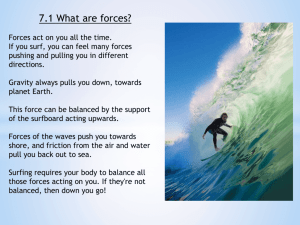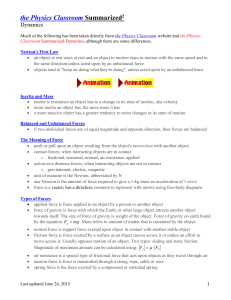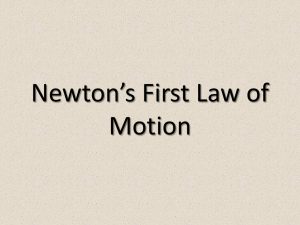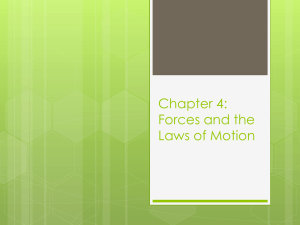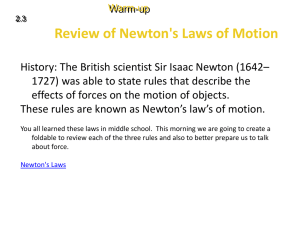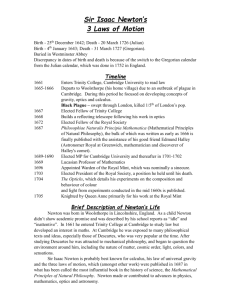Newton*s 1st Law * Objectives:
advertisement
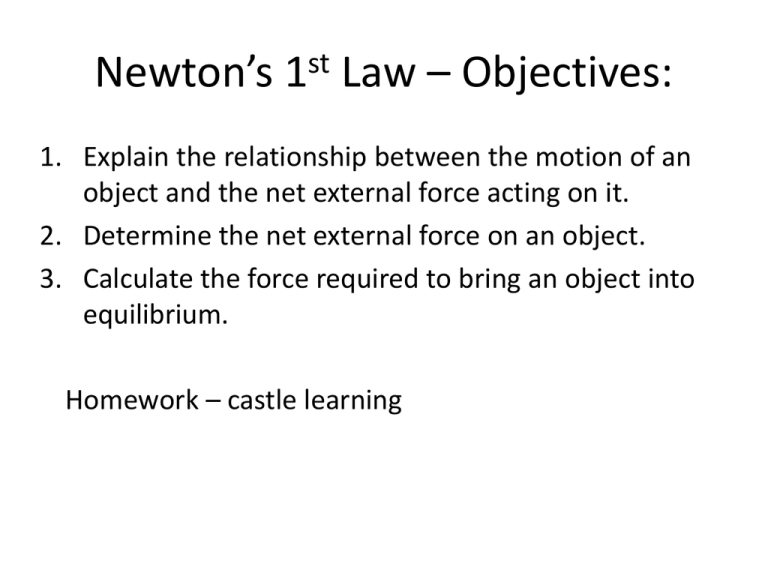
Newton’s 1st Law – Objectives: 1. Explain the relationship between the motion of an object and the net external force acting on it. 2. Determine the net external force on an object. 3. Calculate the force required to bring an object into equilibrium. Homework – castle learning Newton's First Law • Newton's first law of motion: An object at rest stays at rest and an object in motion stays in motion with the same speed and in the same direction unless acted upon by an unbalanced force. Newton’s First Law Also known as the “Law of Inertia” Inertia Tendency of an object to maintain its STATE OF MOTION Forces Don't Keep Objects Moving Newton’s 1st law – the law of inertia • The state of motion of an object is defined by its velocity - the speed with a direction. • Inertia: tendency of an object to resist changes in its velocity. • Inertia: tendency of an object to resist accelerations. Forces Don't Keep Objects Moving Everyday Applications of Newton's First Law Inertia is proportional to MASS Do these guys have a lot of inertia? MORE MASS means MORE INERTIA LOTS OF INERTIA hard to… GET MOVING or STOP Balanced and Unbalanced Forces If two individual forces are of equal magnitude and opposite direction, then the forces are said to be balanced. When only balanced forces act on an object, the object is said to be at equilibrium. Unbalanced forces Acceleration is determined by net external force • Net external force: the resultant force from a vector additions of all external forces acting on an object. • Unbalanced force means there is net external force. • Net external force produce acceleration. • Newton’s 1st law states that an object will not accelerate if the net external force is zero. Equilibrium • Equilibrium is the state in which there is no change in a body’ motion. • Newton’s 1st law states one condition that must be true for equilibrium: the net external force acting on a body in equilbrium must be equal to zero. Determining Net External Force 1. Draw a free body diagram (FBD) 2. Select a coordinate system, and apply it to the FBD. 3. Find the x and y components of all vectors. Ax=AcosθA; Ay=AsinθA; Bx=BcosθB; By=BsinθB … 4. Find the x and y component of the resultant vector: Rx=Ax + Bx …; Ry=Ay + By … 5. Use the Pythagorean theorem to find the magnitude of the resultant vector. 2 2 R Rx Ry 6. Use tan-1 function to find the angle the resultant vector makes Ry with the x-axis. 1 R tan ( ) Rx 7. Evaluate your answer. Determining the Net Force •The net force is the vector sum of all the forces that act upon an object. A 400 N up 30 N B C 200 N down 20 N left R2 = (30N)2 + (40N)2 θ = tan-1(40/30) = 53.1o 40 N Net force is 50 N at 53.1o West of North Example 4A • Joe leaves his physics book on top of drafting table that is inclined at a 35o angle. The FBD shows the forces acting on the book. Find the net external force acting on the book, and determine whether the book will remain at rest in this position. Fn Ff Fg R X (N) Y (N) 0 18 N -11 0 22cos(-55o) 22sin(-55o) 2 0 The net external force is 2 N in the positive x direction, the book will not remain at rest. -55o Class work • Page 133 – practice 4F • Page 135 – section review #1-5


